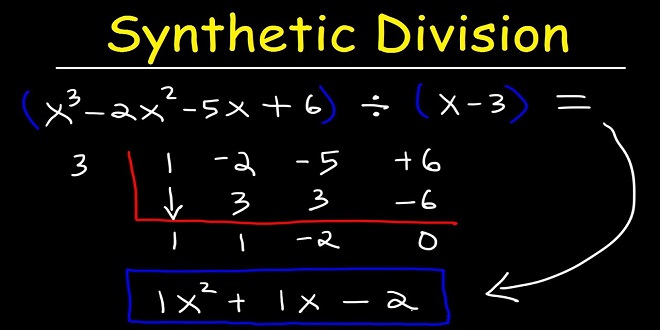The division of a polynomial can be conducted through two methods. One of the methods is the synthetic division method, whereas the other method is termed the long division method. When we compare and contrast the two methods, we can see that the synthetic division method is a method that is easier to follow because the calculations are faster and shorter.
Before we dive deep into what the synthetic division method is, let us understand the meaning of a polynomial. In simple words, a polynomial is an expression in mathematics that contains numbers, variables, exponents, and much more. In polynomials, we can perform various calculations such as division, multiplication, addition, and subtraction by numbers.
Now that we’ve understood what a polynomial is, let’s understand the synthetic division method in detail.
Synthetic Division – What is it?
To understand what synthetic division is, we need to understand the terms associated with it.
First, the number which is divided with the help of another number is called the ‘dividend’. Second, the number with which the above-said dividend is to be divided is called the ‘divisor’. Third, the number produced by dividing to numbers is called the ‘quotient’, and last, the number left after the division method is performed is called the ‘remainder’.
Under the synthetic division of polynomials, the divisor has to be a linear factor. In simpler words, a linear factor is a polynomial of degree 1.
We can further write the equation of synthetic division of polynomials as:
P(X)/(X-A) = Q(X) + [R/(X-A)]
Where,
- P(X) is the polynomial
- (X-A) is termed as the linear divisor
- Q(X) is termed as the quotient polynomial
- R is termed as the remainder, which is always a constant number
Steps Involved in Synthetic Division
One advantage of this division method is that it does not use any variables for calculations, making it less confusing. However, in this method instead of subtraction, we perform addition, and instead of division, we perform multiplication. Let us understand how we can perform this method on polynomials.
First, we write the coefficients of the polynomial and draw a bracket to the left side of the coefficients. We write the divisor by changing its signs right outside the bracket. For example, if the divisor is (x – 2), we write a +2 outside the bracket. Next, we draw a horizontal line above the coefficients.
Second, we place the first coefficient as it is and multiply the divisor with it. Next, we place the product of this multiplication right below the second coefficient and add the numbers present in that column. We repeat this process for all the coefficients.
Third, the last number obtained in the last column after addition is the remainder. And the other digits are put with the coefficients according to their degree as the quotient.
Surprisingly, the polynomial we get after we perform this method is of one order less than the polynomial that we considered to perform the method. One can also evaluate the polynomial by putting the remainder as values in the polynomial. This helps to check whether the remainder matches the polynomial in the solution.
Advantages & Disadvantages of Synthetic Division over Long Division Method
The synthetic Division Method comes with many advantages as compared to long division method. The advantages include:
- This method requires very few steps involved in calculations. The calculations under this method are very easy and not time-consuming.
- This method performs calculations without including the variables. This makes the calculations a little less complex, making it easier to understand and solve.
- There are few to no chances of errors in the calculations. Additionally, you can also check if your calculations are correct by incorporating the value of the remainder in the dividend polynomial. If after evaluating the dividend polynomial, the solution matches the remainder, there are no errors in the calculations.
However, this method can only be performed when the divisor is a linear factor. This means that the divisor has to be a polynomial of degree one. This is the only disadvantage of this method of division.
To learn more about division methods of polynomials and the tricks involved in it, visit Cuemath.
 BESTCITYTRIPS
BESTCITYTRIPS




